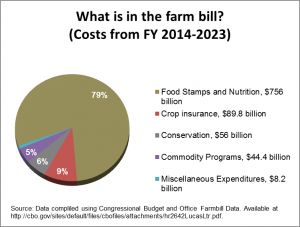Death to Direct Payments
For years congress has tried to dismantle Direct Payments to farmers. These payments are subsidies that occur every year despite whether the farmers need them or not. This creates a void in case of disaster, and that’s where crop insurance will step in. From now on farmers will only be paid in case of a loss, at which point the government will help pay a percentage of that insurance. This means billions of dollars of savings for the taxpayers, and creates a system that is both different and intelligent.
The Farm Bill also addresses the importance of agriculture to the economy as agriculture exports have tripled since 2000. Approximately 16 million people are employed in the agricultural sector and the Farm Bill both invests in research and helps grow the American workforce by adding 8,400 jobs for every $1 billion in exports. Utilizing CBO data we can see what’s exactly in the Farm Bill. We will focus on what makes up the agricultural 21% of the bill; and leave out the staggering 79% that is actually Food Stamps and Nutrition.
- Crop Insurance 9% — This new system could prove effective in reducing the billions the government currently spends. However, the number can vary wildly. Depending on droughts or frosts more money would have to be pushed towards the program instead of the flat rate that was previously implemented.
- Conservation 6% — This portion of the bill implies that all farmers who apply for insurance must comply with federal conservation standards. While the fairness of the government imposing standards on government can be argued, the fact that farmers must meet those standards before receiving handouts is a program worth following. For years congress has attempted to impose similar requirements to welfare programs with no luck. This could be the step in the right direction that Republicans need to further reform SNAP and other assistance programs.
- Commodity Programs 5% — The estimated reduction in spending is currently around 14.3 billion in savings. This would end fixed payments and other existing forms of price and income support to producers.
- Miscellaneous Expenditures 1% — A majority of this portion will go to research for a variety of projects such as anything from research and development to an emphasis on farmers markets. It can also include projects such as biofuels and even trade assistance.
While the Farm Bill is an improvement, it is far from perfect. Part of the new law means that all chicken, pork, and beef sold in the U.S. must have a label that tells where the animal was born, slaughtered and processed. This puts significant pressure on world producers of meat as they must now comply with U.S. standards if they want to continue selling meat to American consumers.
However, these are not the only global effects. Due to the new insurance laws, several new crops such as rice and cotton are now covered by crop insurance. If prices fall below the set amount, the U.S. government will subsidize the difference. This means that many farmers will switch to different crops in order to be protected by the subsidies.
While the bill is far from the ideal version that was presented by U.S. House and free-market republicans, it certainly leads us in the right direction.
